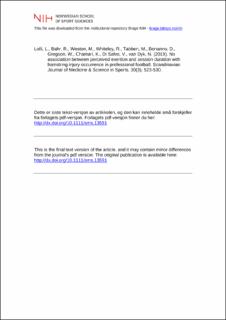| dc.contributor.author | Lolli, Lorenzo | |
| dc.contributor.author | Bahr, Roald | |
| dc.contributor.author | Weston, Matthew | |
| dc.contributor.author | Whiteley, Rodney | |
| dc.contributor.author | Tabben, Montassar | |
| dc.contributor.author | Bonanno, Daniele | |
| dc.contributor.author | Gregson, Warren | |
| dc.contributor.author | Chamari, Karim | |
| dc.contributor.author | Di Salvo, Valter | |
| dc.contributor.author | van Dyk, Nicol | |
| dc.date.accessioned | 2020-10-15T07:59:14Z | |
| dc.date.available | 2020-10-15T07:59:14Z | |
| dc.date.created | 2020-01-29T08:56:28Z | |
| dc.date.issued | 2019 | |
| dc.identifier.citation | Scandinavian Journal of Medicine & Science in Sports. 2019, 30(3), 532-530. | en_US |
| dc.identifier.issn | 0905-7188 | |
| dc.identifier.uri | https://hdl.handle.net/11250/2682944 | |
| dc.description | I Brage finner du siste tekst-versjon av artikkelen, og den kan inneholde ubetydelige forskjeller fra forlagets pdf-versjon. Forlagets pdf-versjon finner du på onlinelibrary.wiley.com / In Brage you'll find the final text version of the article, and it may contain insignificant differences from the journal's pdf version. The definitive version is available at onlinelibrary.wiley.com | en_US |
| dc.description.abstract | Training and competition loads have emerged as modifiable composite risk factors of non‐contact injury. Hamstring strains are the most common injuries in football with substantial burden on the individual player and club. Nevertheless, robust evidence of a consistent load‐hamstring injury relationship in professional football is lacking. Using available data from the Qatar Stars League over three competitive seasons, this study investigated the separate and combined effects of perceived exertion and session duration on hamstring injury occurrence in a sample of 30 outfield football players. Load variables were calculated into 7‐day, 14‐day, 21‐day, 28‐day periods of data, and week‐to‐week changes for average ratings of perceived exertion (RPE; au) score and session‐RPE (s‐RPE; session‐duration urn:x-wiley:09057188:media:sms13591:sms13591-math-0001 score), plus the cumulative training and match minutes and s‐RPE, respectively. Conditional logistic regression models estimated load‐injury relationships per 2‐within‐subject standard deviation increments in each candidate variable. Associations were declared practically important based on the location of the confidence interval in relation to thresholds of 0.90 and 1.11 defining small beneficial and harmful effects, respectively. The uncertainty for the corrected odds ratios show that typically high within‐subject increments in each candidate variable were not practically important for training‐ and match‐related hamstring injury (95% confidence intervals range: 0.85 to 1.16). We found limited exploratory evidence regarding the value of perceived exertion and session duration as etiological factors of hamstring injury in Middle‐East professional football. Monitoring remains valuable to inform player load management strategies, but our exploratory findings suggest its role for type‐specific injury risk determination appears empirically unsupported. | en_US |
| dc.language.iso | eng | en_US |
| dc.subject | hamstrings | en_US |
| dc.subject | load | en_US |
| dc.subject | muscle injury | en_US |
| dc.subject | perceived exertion | en_US |
| dc.subject | risk factors | en_US |
| dc.subject | RPE | en_US |
| dc.title | No association between perceived exertion and session duration with hamstring injury occurrence in professional football | en_US |
| dc.type | Peer reviewed | en_US |
| dc.type | Journal article | en_US |
| dc.description.version | acceptedVersion | en_US |
| dc.source.journal | Scandinavian Journal of Medicine & Science in Sports | en_US |
| dc.identifier.doi | 10.1111/sms.13591 | |
| dc.identifier.cristin | 1784787 | |
| dc.description.localcode | Institutt for idrettsmedisinske fag / Department of Sports Medicine | en_US |
| cristin.ispublished | true | |
| cristin.fulltext | postprint | |
| cristin.qualitycode | 2 | |
